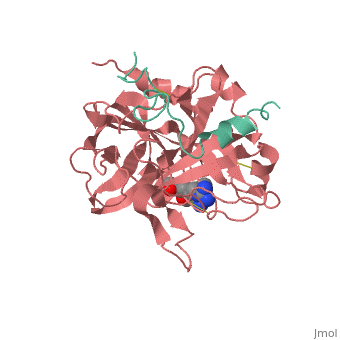Thrombin
Thrombin (Thr) is a serine protease. Prothrombin (PThr) is cleaved to form Thr in the coagulation cascade. The first step of the cleavage is at residue R320 and produces meizothrombin (MThr). Thr catalyzes the conversion of fibrinogen to the insoluble fibrin. Thr is composed of heavy chain (HC) and light chain (LC). Prethrombin-1 lacks 155 N-terminal residues of PThr and is composed of a single polypeptide chain. Prethrombin-2 is the product of proteolysis of prethrombin-1 by trypsin or by active factor X. P-PACK Thr is a chemicaly modified Thr with inactivated catalytic site and active anion binding site. Hirudin is the most potent natural inhibitor of Thr (Sean Swale/Human Thrombin Inhibitor). For some more details see Serine Proteases. Prothrombin cleavage results in the creation of thrombin, a coagulative agent in plasma and is connected to fibrinolysis and platelet activation. During this process several peptides involved in the conversion are released into the plasma, and the remaining protein splits into two portions(http://www.uniprot.org/citations/3759958). It has been shown that prothrombin has a statistically significant connection to the occurrence of ischemic stroke with the presence of the G20210A mutation, though the cause was not isolated to prothrombin alone (http://www.uniprot.org/citations/15534175) (these links added by Connor Gramazio). Some additional details in StructureThrombin is a "trypsin-like" serine protease. Its structure (PDB code 1ppb) is shown here with a peptide chloroketone inhibitor (PPACK). The thrombin A chain (cleaved N terminal fragement) is shown in cyan and the B chain is shown in red. The is made up of a catalytic triad of Ser195, His57 and Asp102, backed up by Ser214. The peptide chloroketone inhibitor (PPACK) is shown in purple. A closeup shows the at which the sidechain of Asp194 makes a salt link with the N-terminus at residue 16, newly formed when the A chain is cleaved in the zymogen-to-enzyme activation process. The specificity pocket is on one side of the throat of the domain 2 beta barrel, and the activation site is close next to it. The B chain consists of . As is true for all of the "trypsin-like" serine proteases, each of the two thrombin domains consists mainly of a 6-stranded, antiparallel beta barrel. The specificity pocket (here filled with the Lys sidechain of the PPACK inhibitor) is in one side of the throat of the domain 2beta barrel, and the activation site is close next to it. |
| ||||||||||
3D Structures of thrombin3D Structures of thrombin
Updated on 11-January-2016
